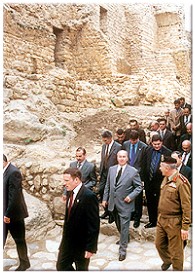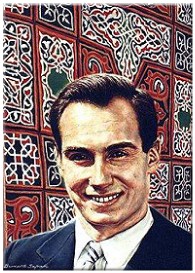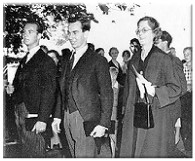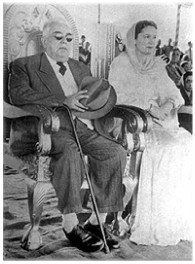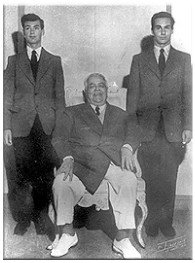Royal Role Model
Lubna Khan
If ever there was an Islamic renaissance, it took place in Egypt, ruled over by the Ismaili Fatimid dynasty
 is Highness
Prince Karim Aga Khan, the 49th hereditary Imam of
the Shia Imami Ismaili Muslims, is one of the
world’s wealthiest and most revered individuals.
Son of Prince Aly Khan and Princess Tajuddawlah
Aly Khan (the name given to renowned beauty Joan
Lady Camrose, upon her marriage to Prince Aly
Khan), the Aga Khan was born in Geneva on December
13th, 1936. He spent his early childhood in
Nairobi, Kenya, followed by Le Rosey School in
Switzerland. He graduated from Harvard University
in 1959 with a BA Honours in Islamic History. At
the age of twenty, and still a student at Harvard,
his grandfather Sir Sultan Mahomed Shah Aga Khan
died, and the Imamat was thrust upon him. The 48th
hereditary Imam unexpectedly bypassed his sons and
named in his will Prince Karim, his elder grandson
with whom he shared a special bond. Prince Karim
assumed the role of spiritual leader to the
Ismaili Muslims on July 11th, 1957.
The honorary, hereditary title of “Aga Khan” was
originally bestowed upon Aga Hassanaly Shah, the
46th Ismaili Imam and the present Aga Khan’s
great-great-grandfather, in the 1830s by the
Persian shah Fateh Ali Shah. In 1843, the first
Aga Khan left Persia and sought refuge in India,
where a large Ismaili community already existed.
Upon recognition by the British Raj as the leader
of the Ismaili community, Queen Victoria conferred
upon him the title “His Highness”. The title has
continued to subsequent generations. In 1881, Aga
Khan I was succeeded as Imam by his son, Aga Ali
Shah. He presided over this mantle for a brief
period of four years till 1885, when he died and
the Imamat passed on to his son, Sir Sultan
Mahomed Shah.
Shah became the third Aga Khan at the age of
eight and was Imam for 72 years, a critical period
in the modern history of the Ismaili community.
His leadership played a crucial role in enabling
the community to adapt to historical change,
notably through the transformation of its
institutions. He also played an important role in
the political evolution of the Indian
sub-continent and was a delegate to the Round
Table conferences in London in the 1930s. From
1937 to 1939 he was President of the League of
Nations. His elder son, Prince Aly Khan, served as
Pakistan’s Ambassador to the United Nations. Sir
Sultan Mahomed Shah’s decision to bypass his son
was brought on by the latter’s playboy reputation
— at one point he was married to Rita Hayworth,
the couple was jointly dubbed the “two most talked
about lovers in the world”. Still the Aga Khan’s
decision to choose his grandson as successor
shocked his followers around the world.
Historians conventionally divide Ismaili history
into several broad periods. The achievements of
the Fatimid Empire dominate accounts of the early
period, roughly from the beginnings of Islam
through the 11th century. Named after the
Prophet’s (PBUH) daughter Fatima (RA), the Fatimid
dynasty created a state that stimulated the
development of art, science and trade in the
Mediterranean Near East over two centuries, with
Cairo as its capital. Following the Fatimid
period, the Ismaili Muslims’ geographical centre
shifted from Egypt to Syria and Persia. Their
capital in Persia, Alamut, fell to Mongol
conquerors in the 13th century. After this,
Ismailis lived for several centuries in dispersed
communities, mainly in Persia and Central Asia but
also in Syria, India and elsewhere.
The Shia Ismailis include people from diverse
cultural traditions, many of whom now live mainly
in Central and South Asia, East Africa and the
Middle East. Like other Shia Muslims, Ismailis
affirm that after the death of the Prophet
Muhammad (PBUH), his cousin and son-in-law Ali
(RA) was designated first Imam, and that this
spiritual leadership, known as Imamat, continues
through the hereditary line of Ali (RA) and his
wife Fatima (RA), the Prophet’s (PBUH) daughter.
However, Ismailis diverged from the mainstream
Shi’ites when they embraced Ismail as their
seventh Imam, instead of his younger brother, Musa
Kazim. Thirteen generations down the line, the
sect split further; over a dispute as to who
should take over the Imamat, with one group
supporting Nizar, and the other opting for his
younger brother and eventually developing into the
Bohra community. Those who recognised Nizar as
Imam developed into what are known as the Aga
Khanis. Even though they are generally described
as Ismailis, it is important to differentiate
between the followers of the Aga Khan, and those
belonging to offshoot communities of the Ismaili
sect, namely the Bohras and the Druzes. It is
therefore accurate to describe Aga Khanis as
“Nizari Ismailis”.
Aga Khanis, or Nizari Ismailis, stand out from
the other Islamic sects with their own distinct
character. To most outsiders, they appear liberal,
even westernised in their manner and beliefs: they
have coeducational schools, women are not expected
to observe purdah, and in their congregation halls
women pray alongside men on carpets that are
separate but adjacent, denoting equal status of
the genders. One of the main factors that have
contributed to this distinctive belief system has
been the outlook and conduct of the community’s
spiritual Imam. According to Ismaili tradition,
the Imam’s responsibilities involve not only
interpretations of matters of faith for the
community, but also the relationship of this faith
with contemporary socio-political scenarios. The
Aga Khan has persistently emphasised Islam as a
thinking, spiritual faith: one that teaches
compassion and tolerance and upholds the dignity
of man.
The present Aga Khan has in many ways epitomised
this attitude. Dubbed “venture capitalist to the
Third World”, as the architect of the Aga Khan
Development Network, Prince Karim Aga Khan has
been deeply involved with development and progress
in many areas of the developing world, not only
through the network of agencies he administers,
but at a personal level as well. These agencies
have mandates that range from the fields of
health, education and rural development to the
enhancement of non-governmental organisations and
the promotion of private-sector enterprises.
Together they collaborate in working towards a
common goal: building institutions and programs
that respond to the challenges of social, economic
and cultural change on an ongoing basis, and
identifying ways in which their efforts can
interact so as to mutually reinforce one another.
As part of its efforts to encourage a revival of
Islamic architecture, the AKDN is also behind the
world’s largest architectural award, the Aga Khan
Award for Architecture, which celebrates its 25th
anniversary in 2003.
The AKDN also has various agencies working within
Pakistan. In addition to the educational,
architectural, environmental and health projects
in full swing in the Northern Areas, the AKDN is
also a major provider of educational and health
services in Pakistan’s other rural areas. One of
the most prominent developments by the AKDN has
been the establishment of the Aga Khan University
(AKU). With headquarters in Karachi, the AKU is a
major centre for education, training and research
in areas of health sciences and education.
Even though a number of the components that now
form the global AKDN were initially established by
Sir Sultan Mahomed Shah Aga Khan in the late
nineteenth century to meet the needs of the
Ismaili community in South Asia and East Africa,
today the AKDN functions within a tradition of
political neutrality, its services open to people
of all faiths and origins. The fulcrum of the
AKDN’s activities, however, remains the Ismaili
community. Philosophically, the network is
grounded in Islam’s ethic of inclusiveness,
compassion, sharing, self-reliance, respect for
health and life, the cultivation of a sound and
enlightened mind, and humanity’s collective
responsibility for sustainable physical, social
and cultural development. The network represents a
contemporary endeavour of the Ismaili Imamat to
realise the social conscience of Islam through
institutional action and has been an essential
development force in many areas all over the
globe.
In the Aga Khan’s own words, “We are trustees of
God’s creation, and we are instructed to seek to
leave the world a better place than it was when we
came into it.” And that ‘better place’, in
physical terms clearly means trying to improve the
quality of life for future generations.
is Highness
Prince Karim Aga Khan, the 49th hereditary Imam of
the Shia Imami Ismaili Muslims, is one of the
world’s wealthiest and most revered individuals.
Son of Prince Aly Khan and Princess Tajuddawlah
Aly Khan (the name given to renowned beauty Joan
Lady Camrose, upon her marriage to Prince Aly
Khan), the Aga Khan was born in Geneva on December
13th, 1936. He spent his early childhood in
Nairobi, Kenya, followed by Le Rosey School in
Switzerland. He graduated from Harvard University
in 1959 with a BA Honours in Islamic History. At
the age of twenty, and still a student at Harvard,
his grandfather Sir Sultan Mahomed Shah Aga Khan
died, and the Imamat was thrust upon him. The 48th
hereditary Imam unexpectedly bypassed his sons and
named in his will Prince Karim, his elder grandson
with whom he shared a special bond. Prince Karim
assumed the role of spiritual leader to the
Ismaili Muslims on July 11th, 1957.
The honorary, hereditary title of “Aga Khan” was
originally bestowed upon Aga Hassanaly Shah, the
46th Ismaili Imam and the present Aga Khan’s
great-great-grandfather, in the 1830s by the
Persian shah Fateh Ali Shah. In 1843, the first
Aga Khan left Persia and sought refuge in India,
where a large Ismaili community already existed.
Upon recognition by the British Raj as the leader
of the Ismaili community, Queen Victoria conferred
upon him the title “His Highness”. The title has
continued to subsequent generations. In 1881, Aga
Khan I was succeeded as Imam by his son, Aga Ali
Shah. He presided over this mantle for a brief
period of four years till 1885, when he died and
the Imamat passed on to his son, Sir Sultan
Mahomed Shah.
Shah became the third Aga Khan at the age of
eight and was Imam for 72 years, a critical period
in the modern history of the Ismaili community.
His leadership played a crucial role in enabling
the community to adapt to historical change,
notably through the transformation of its
institutions. He also played an important role in
the political evolution of the Indian
sub-continent and was a delegate to the Round
Table conferences in London in the 1930s. From
1937 to 1939 he was President of the League of
Nations. His elder son, Prince Aly Khan, served as
Pakistan’s Ambassador to the United Nations. Sir
Sultan Mahomed Shah’s decision to bypass his son
was brought on by the latter’s playboy reputation
— at one point he was married to Rita Hayworth,
the couple was jointly dubbed the “two most talked
about lovers in the world”. Still the Aga Khan’s
decision to choose his grandson as successor
shocked his followers around the world.
Historians conventionally divide Ismaili history
into several broad periods. The achievements of
the Fatimid Empire dominate accounts of the early
period, roughly from the beginnings of Islam
through the 11th century. Named after the
Prophet’s (PBUH) daughter Fatima (RA), the Fatimid
dynasty created a state that stimulated the
development of art, science and trade in the
Mediterranean Near East over two centuries, with
Cairo as its capital. Following the Fatimid
period, the Ismaili Muslims’ geographical centre
shifted from Egypt to Syria and Persia. Their
capital in Persia, Alamut, fell to Mongol
conquerors in the 13th century. After this,
Ismailis lived for several centuries in dispersed
communities, mainly in Persia and Central Asia but
also in Syria, India and elsewhere.
The Shia Ismailis include people from diverse
cultural traditions, many of whom now live mainly
in Central and South Asia, East Africa and the
Middle East. Like other Shia Muslims, Ismailis
affirm that after the death of the Prophet
Muhammad (PBUH), his cousin and son-in-law Ali
(RA) was designated first Imam, and that this
spiritual leadership, known as Imamat, continues
through the hereditary line of Ali (RA) and his
wife Fatima (RA), the Prophet’s (PBUH) daughter.
However, Ismailis diverged from the mainstream
Shi’ites when they embraced Ismail as their
seventh Imam, instead of his younger brother, Musa
Kazim. Thirteen generations down the line, the
sect split further; over a dispute as to who
should take over the Imamat, with one group
supporting Nizar, and the other opting for his
younger brother and eventually developing into the
Bohra community. Those who recognised Nizar as
Imam developed into what are known as the Aga
Khanis. Even though they are generally described
as Ismailis, it is important to differentiate
between the followers of the Aga Khan, and those
belonging to offshoot communities of the Ismaili
sect, namely the Bohras and the Druzes. It is
therefore accurate to describe Aga Khanis as
“Nizari Ismailis”.
Aga Khanis, or Nizari Ismailis, stand out from
the other Islamic sects with their own distinct
character. To most outsiders, they appear liberal,
even westernised in their manner and beliefs: they
have coeducational schools, women are not expected
to observe purdah, and in their congregation halls
women pray alongside men on carpets that are
separate but adjacent, denoting equal status of
the genders. One of the main factors that have
contributed to this distinctive belief system has
been the outlook and conduct of the community’s
spiritual Imam. According to Ismaili tradition,
the Imam’s responsibilities involve not only
interpretations of matters of faith for the
community, but also the relationship of this faith
with contemporary socio-political scenarios. The
Aga Khan has persistently emphasised Islam as a
thinking, spiritual faith: one that teaches
compassion and tolerance and upholds the dignity
of man.
The present Aga Khan has in many ways epitomised
this attitude. Dubbed “venture capitalist to the
Third World”, as the architect of the Aga Khan
Development Network, Prince Karim Aga Khan has
been deeply involved with development and progress
in many areas of the developing world, not only
through the network of agencies he administers,
but at a personal level as well. These agencies
have mandates that range from the fields of
health, education and rural development to the
enhancement of non-governmental organisations and
the promotion of private-sector enterprises.
Together they collaborate in working towards a
common goal: building institutions and programs
that respond to the challenges of social, economic
and cultural change on an ongoing basis, and
identifying ways in which their efforts can
interact so as to mutually reinforce one another.
As part of its efforts to encourage a revival of
Islamic architecture, the AKDN is also behind the
world’s largest architectural award, the Aga Khan
Award for Architecture, which celebrates its 25th
anniversary in 2003.
The AKDN also has various agencies working within
Pakistan. In addition to the educational,
architectural, environmental and health projects
in full swing in the Northern Areas, the AKDN is
also a major provider of educational and health
services in Pakistan’s other rural areas. One of
the most prominent developments by the AKDN has
been the establishment of the Aga Khan University
(AKU). With headquarters in Karachi, the AKU is a
major centre for education, training and research
in areas of health sciences and education.
Even though a number of the components that now
form the global AKDN were initially established by
Sir Sultan Mahomed Shah Aga Khan in the late
nineteenth century to meet the needs of the
Ismaili community in South Asia and East Africa,
today the AKDN functions within a tradition of
political neutrality, its services open to people
of all faiths and origins. The fulcrum of the
AKDN’s activities, however, remains the Ismaili
community. Philosophically, the network is
grounded in Islam’s ethic of inclusiveness,
compassion, sharing, self-reliance, respect for
health and life, the cultivation of a sound and
enlightened mind, and humanity’s collective
responsibility for sustainable physical, social
and cultural development. The network represents a
contemporary endeavour of the Ismaili Imamat to
realise the social conscience of Islam through
institutional action and has been an essential
development force in many areas all over the
globe.
In the Aga Khan’s own words, “We are trustees of
God’s creation, and we are instructed to seek to
leave the world a better place than it was when we
came into it.” And that ‘better place’, in
physical terms clearly means trying to improve the
quality of life for future generations.
The Friday Times
http://www.thefridaytimes.com./news15.htm
